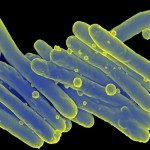Lien vers Pubmed [PMID] – 33529148
Lien DOI – 10.1099/mgen.0.000505
Microb Genom 2021 02; 7(2):
Mycobacterium microti is an animal-adapted member of the Mycobacterium tuberculosis complex (MTBC), which was originally isolated from voles, but has more recently also been isolated from other selected mammalian hosts, including occasionally from humans. Here, we have generated and analysed the complete genome sequences of five representative vole and clinical M. microti isolates using PacBio- and Illumina-based technologies, and have tested their virulence and vaccine potential in SCID (severe combined immune deficient) mouse and/or guinea pig infection models. We show that the clinical isolates studied here cluster separately in the phylogenetic tree from vole isolates and other clades from publicly available M. microti genome sequences. These data also confirm that the vole and clinical M. microti isolates were all lacking the specific RD1mic region, which in other tubercle bacilli encodes the ESX-1 type VII secretion system. Biochemical analysis further revealed marked phenotypic differences between isolates in type VII-mediated secretion of selected PE and PPE proteins, which in part were attributed to specific genetic polymorphisms. Infection experiments in the highly susceptible SCID mouse model showed that the clinical isolates were significantly more virulent than the tested vole isolates, but still much less virulent than the M. tuberculosis H37Rv control strain. The strong attenuation of the ATCC 35872 vole isolate in immunocompromised mice, even compared to the attenuated BCG (bacillus Calmette-Guérin) vaccine, and its historic use in human vaccine trials encouraged us to test this strain’s vaccine potential in a guinea pig model, where it demonstrated similar protective efficacy as a BCG control, making it a strong candidate for vaccination of immunocompromised individuals in whom BCG vaccination is contra-indicated. Overall, we provide new insights into the genomic and phenotypic variabilities and particularities of members of an understudied clade of the MTBC, which all share a recent common ancestor that is characterized by the deletion of the RD1mic region.






